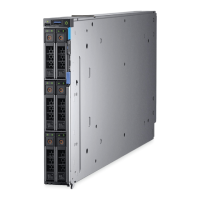4 On the System BIOS screen, click Integrated Devices.
Integrated Devices details
The Integrated Devices screen details are explained as follows:
Option Description
User Accessible
USB Ports
Congures the user accessible USB ports. Selecting Only Back Ports On disables the front USB ports; selecting
All Ports O disables all front and back USB ports;
The USB keyboard and mouse still function in certain USB ports during the boot process, depending on the
selection. After the boot process is complete, the USB ports will be enabled or disabled as per the setting.
NOTE: Selecting Only Back Ports On and All Ports O disables the USB management port and also
restricts access to the iDRAC features.
Internal USB Port Enables or disables the internal USB port. This option is set to On or O. This option is set to On by default.
iDRAC Direct USB
Port
The iDRAC Direct USB port is managed by iDRAC exclusively with no host visibility. This option is set to ON or
OFF. When set to OFF, iDRAC does not detect any USB devices installed in this managed port. This option is set
to On by default.
Embedded NIC1
and NIC2
NOTE: The Embedded NIC1 and NIC2 options are only available on systems that do not have Integrated
Network Card 1.
Enables or disables the Embedded NIC1 and NIC2 options. If set to Disabled, the NIC may still be available for
shared network access by the embedded management controller. The embedded NIC1 and NIC2 options are only
available on systems that do not have Network Daughter Cards (NDCs). The Embedded NIC1 and NIC2 option is
mutually exclusive with the Integrated Network Card 1 option. Congure the Embedded NIC1 and NIC2 option by
using the NIC management utilities of the system.
I/OAT DMA Engine Enables or disables the I/O Acceleration Technology (I/OAT) option. I/OAT is a set of DMA features designed to
accelerate network trac and lower CPU utilization. Enable only if the hardware and software support the feature.
Embedded Video
Controller
Enables or disables the use of Embedded Video Controller as the primary display. When set to Enabled, the
Embedded Video Controller will be the primary display even if add-in graphic cards are installed. When set to
Disabled, an add-in graphics card will be used as the primary display. BIOS will output displays to both the primary
add-in video and the embedded video during POST and pre-boot environment. The embedded video will then be
disabled right before the operating system boots. This option is set to
Enabled by default.
NOTE: When there are multiple add-in graphic cards installed in the system, the rst card discovered
during PCI enumeration is selected as the primary video. You might have to re-arrange the cards in the
slots in order to control which card is the primary video.
Current State of
Embedded Video
Controller
Displays the current state of the embedded video controller. The Current State of Embedded Video Controller
option is a read-only eld. If the Embedded Video Controller is the only display capability in the system (that is, no
add-in graphics card is installed), then the Embedded Video Controller is automatically used as the primary display
even if the Embedded Video Controller setting is set to Enabled.
OS Watchdog
Timer
If your system stops responding, this watchdog timer aids in the recovery of your operating system. When this
option is set to Enabled, the operating system initializes the timer. When this option is set to Disabled (the
default), the timer does not have any eect on the system.
Memory Mapped
I/O above 4 GB
Enables or disables the support for the PCIe devices that need large amounts of memory. Enable this option only
for 64-bit operating systems. This option is set to Enabled by default.
Slot Disablement Enables or disables the available PCIe slots on your system. The slot disablement feature controls the conguration
of the PCIe cards installed in the specied slot. Slots must be disabled only when the installed peripheral card
prevents booting into the operating system or causes delays in system startup. If the slot is disabled, both the
Option ROM and UEFI drivers are disabled. Only slots that are present on the system will be available for control.
Pre-operating system management applications 31

